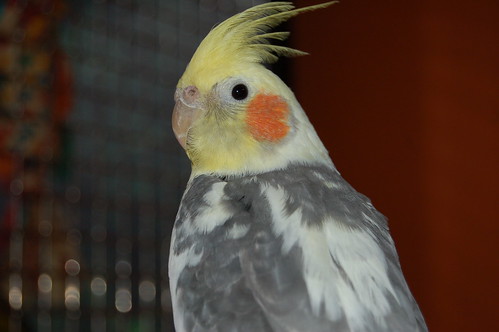
Q: " I have a seven year old male cockatiel, Cubby, that I have always had a close bond with. We were best friends until six months ago when I got another cockatiel (male) to keep him company. Now he wants is to spend all of his time with his new best friend, and he doesn’t seem to like me any more."
Mallory, H., New London, CT
A: I had a similar experience with my cockatiels. Tinky came into our lives as a reward to my daughter for bringing up her grades in school. He was such a joy to have around, and was so well socialized to everyone in the family that we would sometimes argue over who got play with him. We eventually decided to get another, not intending so much for him to be company for Tinky, as there was no short supply of that for this dear bird, but it would give us another cockatiel to love and dote upon. As it was, Tinky had a daily itinerary that divided his out of cage time among the different family members.

When we brought DeeDee home, (also a male, but our young daughter was assigned to naming him and couldn’t be talked out of this one), he was kept in a separate cage but in the same room as Tinky (this was some time before quarantine was recognized as a necessity it avian husbandry). The two immediately took to each other and spent much time clinging to the cage sides and calling to each other. Eventually, they were housed together.
Not too long after the two birds were sharing a cage, we began to notice some changes in Tinky in terms of his willingness to interact with the family. DeeDee was impatient with our attempts to bring him around to being a family bird. This was a disheartening period for us.
After all, our intentions were to have two birds to love and share life with and now it seemed we had none. Somehow, we needed to keep Tinky interactive, and persuade DeeDee to be interactive, while still allowing them each others company. We discussed a strategy, and settled on one. Back to the itinerary.

What we did was not complicated, but it was effective. We decided, for the time being, to put the birds back into separate cages but this time keeping them in separate rooms. We divided up their out of cage time amongst the family members, as before, but this time the schedule gave Tinky time with each of us, the same allotment for DeeDee, and time for the two birds together with each of us.
The alone time spent with Tinky helped to re-establish and maintain our bonds with him. The time spent with DeeDee was helpful in trust building with this new family member. They had their special time together, in our presence, which gave DeeDee the opportunity to watch Tinky interact with his human family. This served to show DeeDee that humans are safe and trusted by Tinky, and that we can be tons of fun. Sometimes we come bearing delicious treats.

Once we felt confident that we had completed our mission, the two birds were once again caged together. Tinky has remained loyal to his humans, bur while DeeDee bonded to a degree with our daughter, he did not with my husband or myself. He is friendly but still aloof , definitely preferring Tinky’s company over ours. This is fine with me. He is polite and cooperative when the situation calls for such behavior, so I try not to have hurt feelings over his choice for companionship.
We were mistaken in our thinking that a second cockatiel would mirror the behavior of our first. And we were unprepared as to how adding a second bird to the home might change the sense of loyalty in the Tinky’s heart. With a little gentle guidance from the human flock members, it all turned out well in the end.
Patty Jourgensen specializes in avian health, behavior and nutrition and has been working with and caring for rescue birds since 1987.


29 comments
Leave a comment